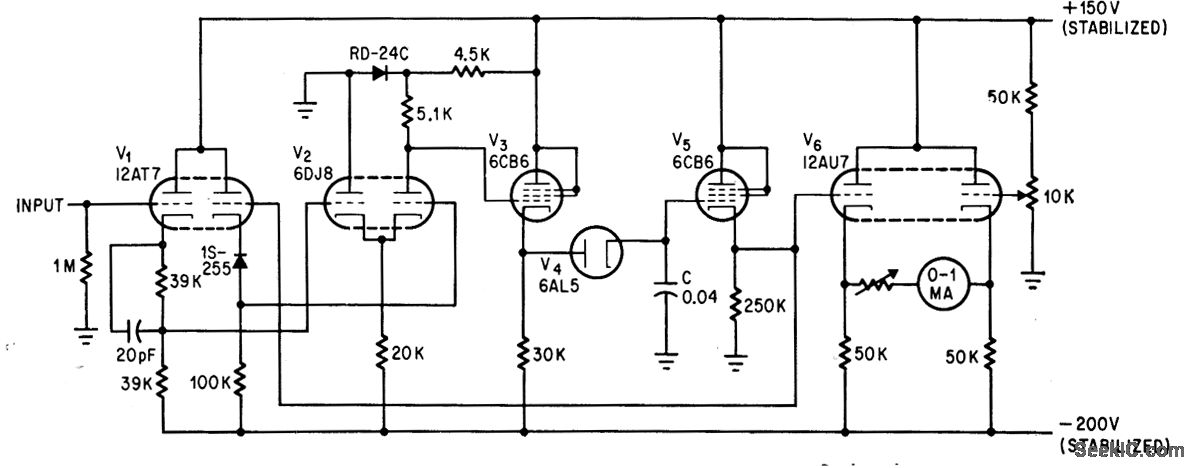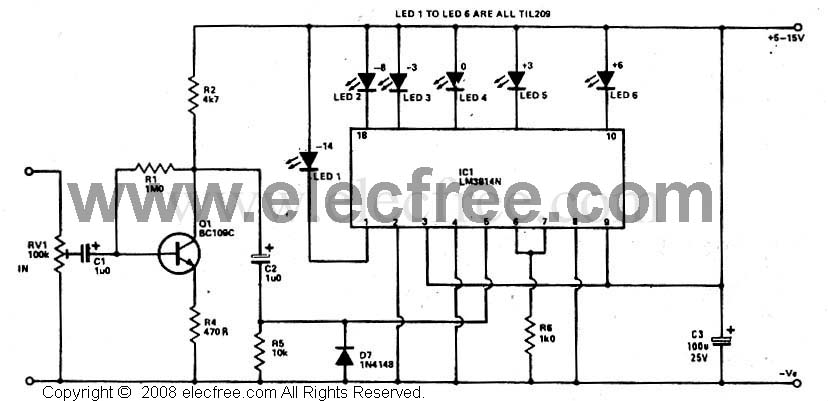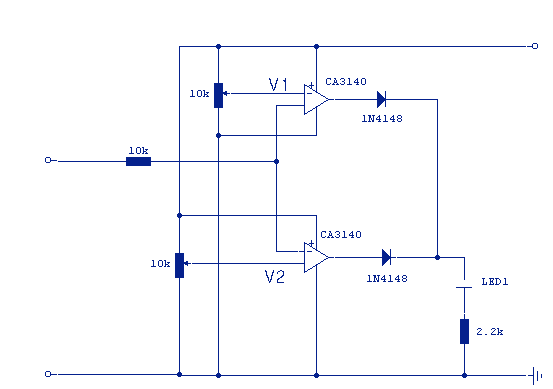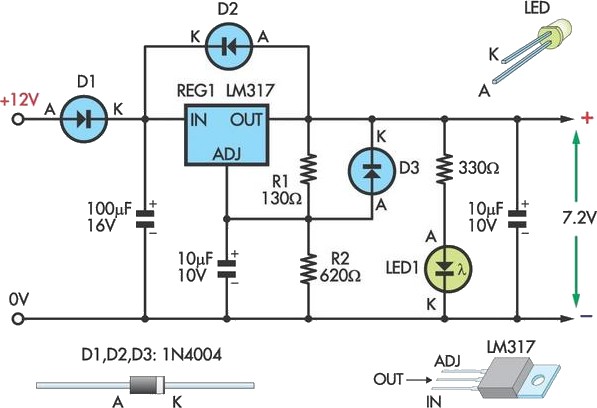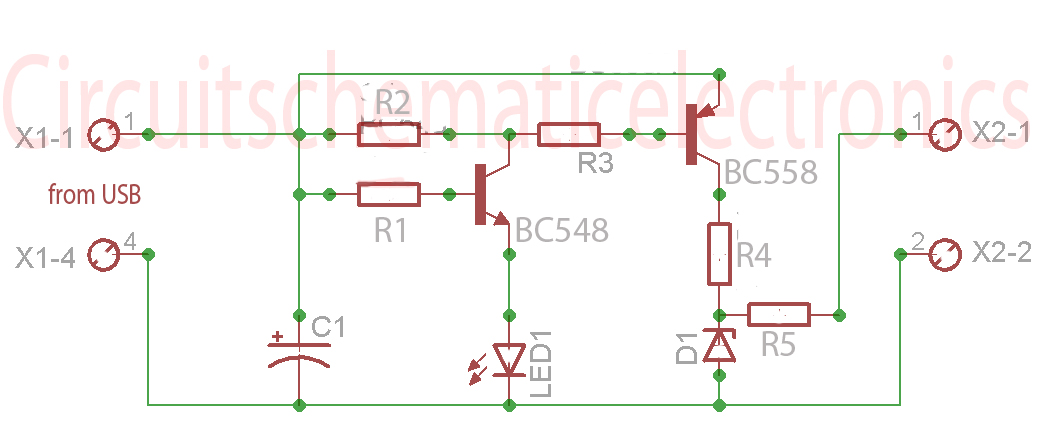
Expanded Scale Battery Volt Meter

This circuit is designed to measure the voltage of a 12V nominal lead-acid rechargeable battery system. While it was specifically created for solar-powered systems, it is versatile enough for use in automotive or other 12V applications. Lead-acid batteries typically operate within a voltage range of 11-15 volts. The meter is intended to display voltage levels from 10 to 15V on an analog meter movement, indicating the battery's charge state from empty to full. The input voltage is filtered from transient voltage spikes using a 10-ohm resistor and a 0.1µF capacitor connected to the input of the 78L08 voltage regulator. A 1 Amp series fuse and a Transzorb protect the circuit from short circuits and over-voltage conditions. The 78L08 voltage regulator provides a stable 8V DC supply to the meter circuitry across the 10-15V input voltage range. A dual op-amp is powered by 0V and 8V for the power rail inputs. The lower op-amp functions as a buffer stage, creating a 4V virtual ground reference voltage, which serves as a current sink for the meter and a reference point for the other op-amp. If the 78L08 regulator is difficult to obtain, the LM317L adjustable regulator set to 8V is a suitable alternative. Other dual op-amps, such as the 1458, can also be employed in this circuit, with ultra-low power options available if power consumption is a concern. The upper op-amp is configured as a voltage summing circuit with adjustable gain, controlled by a 100K feedback resistor. The gain control adjusts the meter's sensitivity across the voltage range. The measured voltage enters the upper op-amp's positive input through a voltage divider consisting of 100K and 47K resistors. An offset control generates a second positive input voltage that is summed with the measured voltage via a 68K resistor. Adjusting this control shifts the meter's position, allowing for calibration to show zero when the minimum measured voltage (10V) is applied. The meter utilized has a sensitive 50µA full-scale reading, but more common 1mA meters may be used by reducing the 47K series resistor to 2.5K. A piece of perforated circuit board, approximately 1"x3", was drilled with two holes to facilitate mounting on the analog meter's terminals. Components were assembled on the board and interconnected with point-to-point wiring, using Teflon insulation over bare wires for cross-board connections. The battery leads were twisted together and secured to the circuit board's edge with a wire loop to prevent movement. The meter was mounted on a 4"x4" metal plate, which was cut and drilled to fit a standard electrical switch box. The box must be sufficiently deep to ensure that the meter and circuit board do not contact the back. The circuit should be wired in parallel with a digital voltmeter, with both meters connected to a stable variable voltage power supply capable of operating within the 10-15V DC range. To calibrate the system, set the input voltage to 12.5V, adjust the gain control to the midpoint, and fine-tune the offset control until the meter reads at the center of its range. While monitoring the digital meter, adjust the input voltage to 12.0V and observe the analog meter's position. Then, increase the input voltage to 13.0V and note the meter's response. If the meter's indication changes by more than 1V, reduce the gain control; if it changes by less, increase the control. This process should be repeated until the meter accurately reflects a 1V change. With the input voltage set to 12.5V, adjust the offset control to ensure the meter reads 12.5V accurately. It may be necessary to alternately adjust both controls for precise alignment. Finally, observe the meter readings at 10.0V and 15.0V, making adjustments until the readings are accurate across the entire voltage range. The circuit should then be connected across a 12V battery.
The circuit's design emphasizes stability and accuracy in voltage measurement, making it suitable for various applications where monitoring battery voltage is critical. The filtering components ensure that transient voltage spikes do not affect the readings, while protective elements safeguard against potential damage from short circuits or over-voltage scenarios. The dual op-amp configuration allows for flexible gain and offset adjustments, enabling precise calibration to accommodate different meter types and ensure accurate voltage representation across the operational range. The use of a perforated circuit board simplifies assembly and provides a robust platform for mounting components, while the careful construction and wiring techniques enhance reliability and performance in practical applications. Overall, this circuit serves as an effective tool for monitoring the state of charge in lead-acid batteries, offering valuable insights for users in solar, automotive, and other 12V system contexts.This circuit is used to measure the voltage on a 12V (nominal) lead acid rechargeable battery system. It was specifically designed for use in solar powered systems, but is general enough that it can be used for automotive or other 12V systems.
Lead acid batteries normally spend their working lifetime in the voltage range of 11-15 Volts. This meter circuit was designed to show the voltage range of 10-15V on an analog meter movement, it can be used to show the battery charge state from empty to full. The input voltage is filtered from transient voltage spikes via the 10 ohm resistor and the 0. 1uF capacitor on the input of the 78L08 regulator. The 1 Amp series fuse and Transzorb protect the circuitry from short circuits and over-voltage conditions.
The 78L08 voltage regulator provides a constant 8V DC supply to the meter circuitry through the 10-15V input voltage range. The dual op-amp is supplied with 0V and 8V for the power rail inputs. The lower op-amp is set up as a buffer stage to provide a 4V virtual ground reference voltage. The virtual ground is used as a current sink for the meter, and as a reference point for the other op-amp.
A 78L08 regulator may be a difficult part to find, a good replacement would be an LM317L adjustable regulator circuit set to 8V. Other dual op-amps should work well in this circuit, the 1458 is a good substitution, an ultra-low power dual op-amp can be used if power drain is a consideration.
The upper op-amp is configured as a voltage summing circuit with adjustable gain. Gain is controlled by the 100K feedback resistor. The gain control adjusts the meter sensitivity across a voltage range. The measured voltage comes into the upper op-amp`s + input via a 100K/47K voltage divider. The offset control creates a second + input voltage that is summed with the measured voltage through the 68K resistor. Adjustment of this control moves the meter position up and down, it is used to set the meter movement at 0 when the minimum measured voltage (10V) is applied to the circuit.
The meter shown has a sensitive 50uA full scale reading, more common 1ma meters can be used by reducing the value of the 47K meter series resistor to 2. 5K. An approximately 1"x3" piece of perforated circuit board material was drilled with two holes so that the board could be mounted on the two terminals of the analog meter.
The parts were assembled on the perforated board and connected together with point-to-point wiring. Teflon insulation was used over bare wires to make the cross-board connections. The two battery leads were twisted together, then secured to the edge of the circuit board with a loop of wire to prevent movement. The meter was mounted on a 4"x4" metal plate that was cut and drilled to fit onto a standard electrical switch box.
The box should be deep enough that the meter and accompanying circuit board do not touch the back of the box. The circuit should be wired in parallel with a digital Volt meter, both meters should be connected to a stable variable voltage power supply that is capable of operation in the 10-15V DC range.
Set the input voltage to 12. 5V, set the gain control to midway, and adjust the offset control until the meter reads in the center of its range. While watching the digital meter, move the input voltage to 12. 0V. Observe the analog meter position. Adjust the input voltage to 13. 0V and observe the meter position again. If the meter swings more than 1V on the dial, decrease the gain control. If it swings less, increase the control. Repeat this until the meter accurately measures a 1V change. Set the input voltage to 12. 5V, adjust the offset control so that the meter shows 12. 5V. It will probably be necessary to adjust both controls alternately to get the meter aligned exactly. Observe the meter readings at 10. 0V and 15. 0V, adjust the controls until it reads the end-point voltage accurately. Connect the circuit across a 12V batter 🔗 External reference
The circuit's design emphasizes stability and accuracy in voltage measurement, making it suitable for various applications where monitoring battery voltage is critical. The filtering components ensure that transient voltage spikes do not affect the readings, while protective elements safeguard against potential damage from short circuits or over-voltage scenarios. The dual op-amp configuration allows for flexible gain and offset adjustments, enabling precise calibration to accommodate different meter types and ensure accurate voltage representation across the operational range. The use of a perforated circuit board simplifies assembly and provides a robust platform for mounting components, while the careful construction and wiring techniques enhance reliability and performance in practical applications. Overall, this circuit serves as an effective tool for monitoring the state of charge in lead-acid batteries, offering valuable insights for users in solar, automotive, and other 12V system contexts.This circuit is used to measure the voltage on a 12V (nominal) lead acid rechargeable battery system. It was specifically designed for use in solar powered systems, but is general enough that it can be used for automotive or other 12V systems.
Lead acid batteries normally spend their working lifetime in the voltage range of 11-15 Volts. This meter circuit was designed to show the voltage range of 10-15V on an analog meter movement, it can be used to show the battery charge state from empty to full. The input voltage is filtered from transient voltage spikes via the 10 ohm resistor and the 0. 1uF capacitor on the input of the 78L08 regulator. The 1 Amp series fuse and Transzorb protect the circuitry from short circuits and over-voltage conditions.
The 78L08 voltage regulator provides a constant 8V DC supply to the meter circuitry through the 10-15V input voltage range. The dual op-amp is supplied with 0V and 8V for the power rail inputs. The lower op-amp is set up as a buffer stage to provide a 4V virtual ground reference voltage. The virtual ground is used as a current sink for the meter, and as a reference point for the other op-amp.
A 78L08 regulator may be a difficult part to find, a good replacement would be an LM317L adjustable regulator circuit set to 8V. Other dual op-amps should work well in this circuit, the 1458 is a good substitution, an ultra-low power dual op-amp can be used if power drain is a consideration.
The upper op-amp is configured as a voltage summing circuit with adjustable gain. Gain is controlled by the 100K feedback resistor. The gain control adjusts the meter sensitivity across a voltage range. The measured voltage comes into the upper op-amp`s + input via a 100K/47K voltage divider. The offset control creates a second + input voltage that is summed with the measured voltage through the 68K resistor. Adjustment of this control moves the meter position up and down, it is used to set the meter movement at 0 when the minimum measured voltage (10V) is applied to the circuit.
The meter shown has a sensitive 50uA full scale reading, more common 1ma meters can be used by reducing the value of the 47K meter series resistor to 2. 5K. An approximately 1"x3" piece of perforated circuit board material was drilled with two holes so that the board could be mounted on the two terminals of the analog meter.
The parts were assembled on the perforated board and connected together with point-to-point wiring. Teflon insulation was used over bare wires to make the cross-board connections. The two battery leads were twisted together, then secured to the edge of the circuit board with a loop of wire to prevent movement. The meter was mounted on a 4"x4" metal plate that was cut and drilled to fit onto a standard electrical switch box.
The box should be deep enough that the meter and accompanying circuit board do not touch the back of the box. The circuit should be wired in parallel with a digital Volt meter, both meters should be connected to a stable variable voltage power supply that is capable of operation in the 10-15V DC range.
Set the input voltage to 12. 5V, set the gain control to midway, and adjust the offset control until the meter reads in the center of its range. While watching the digital meter, move the input voltage to 12. 0V. Observe the analog meter position. Adjust the input voltage to 13. 0V and observe the meter position again. If the meter swings more than 1V on the dial, decrease the gain control. If it swings less, increase the control. Repeat this until the meter accurately measures a 1V change. Set the input voltage to 12. 5V, adjust the offset control so that the meter shows 12. 5V. It will probably be necessary to adjust both controls alternately to get the meter aligned exactly. Observe the meter readings at 10. 0V and 15. 0V, adjust the controls until it reads the end-point voltage accurately. Connect the circuit across a 12V batter 🔗 External reference
Warning: include(partials/cookie-banner.php): Failed to open stream: Permission denied in /var/www/html/nextgr/view-circuit.php on line 713
Warning: include(): Failed opening 'partials/cookie-banner.php' for inclusion (include_path='.:/usr/share/php') in /var/www/html/nextgr/view-circuit.php on line 713
